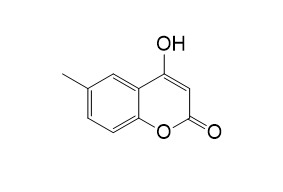4-Hydroxy-6-methylcoumarin
Reference standards.
Inquire / Order:
manager@chemfaces.com
Technical Inquiries:
service@chemfaces.com
Tel:
+86-27-84237783
Fax:
+86-27-84254680
Address:
1 Building, No. 83, CheCheng Rd., Wuhan Economic and Technological Development Zone, Wuhan, Hubei 430056, PRC
Providing storage is as stated on the product vial and the vial is kept tightly sealed, the product can be stored for up to
24 months(2-8C).
Wherever possible, you should prepare and use solutions on the same day. However, if you need to make up stock solutions in advance, we recommend that you store the solution as aliquots in tightly sealed vials at -20C. Generally, these will be useable for up to two weeks. Before use, and prior to opening the vial we recommend that you allow your product to equilibrate to room temperature for at least 1 hour.
Need more advice on solubility, usage and handling? Please email to: service@chemfaces.com
The packaging of the product may have turned upside down during transportation, resulting in the natural compounds adhering to the neck or cap of the vial. take the vial out of its packaging and gently shake to let the compounds fall to the bottom of the vial. for liquid products, centrifuge at 200-500 RPM to gather the liquid at the bottom of the vial. try to avoid loss or contamination during handling.
Anesth Pain Med (Seoul).2020, 15(4):478-485.
Molecules.2021, 26(18):5665.
Sci Rep.2024, 14(1):31213.
J. of The Korean Society of Food Culture2017, 144-149
Phytomedicine.2022, 100:154085.
Appl. Sci. 2021, 11(8),3437.
Foods.2020, 9(10):1348.
Cardiovasc Toxicol.2019, 19(4):297-305
Nat Plants.2016, 3:16205
J Appl Toxicol.2024, jat.4615.
Related and Featured Products
Chemistry, 2015, 20(42):13644-13655.
Synthesis of New Chlorin e6 Trimethyl and Protoporphyrin IX Dimethyl Ester Derivatives and Their Photophysical and Electrochemical Characterizations.[Reference:
WebLink]
In view of increasing demands for efficient photosensitizers for photodynamic therapy (PDT), this paper reports the synthesis and photophysical characterizations of new chlorin e6 trimethyl ester and protoporphyrin-IX dimethyl ester dyads as free-bases and Zn(II) complexes.
METHODS AND RESULTS:
The synthesis of these molecules linked at the β-pyrrolic positions to pyrano[3,2-c]coumarin, pyrano[3,2-c]quinolinone and pyrano[3,2-c]naphthoquinone moieties was performed by using the domino Knoevenagel hetero Diels-Alder reaction. The α-methylenechromanes, α-methylenequinoline and ortho-quinone methides were generated in situ from Knoevenagel reaction respectively of 4-hydroxycoumarin, 4-Hydroxy-6-methylcoumarin, 4-hydroxy-N-methylquinolinone and 2-hydroxy-1,4-naphthoquinone with paraformaldehyde in dioxane. All the dyads as free-bases and as Zn(II) complexes were obtained in high yields. All new compounds were fully characterized by 1D and 2D NMR techniques, UV-Vis and HRMS. Their photophysical properties were evaluated by measuring the fluorescence, singlet oxygen quantum yield by luminescence detection and also the triplet lifetimes were correlated by flash photolysis and intersystem crossing (ISC) rates. The fluorescence lifetimes were measured by time correlated single photon count (TCSPC) method, fluorescence decay associated spectra (FDAS) and anisotropy measurements.
CONCLUSIONS:
Magnetic circular dichroism (MCD) and circular dichroism (CD) spectra were recorded for one Zn(II) complex in order to obtain information, respectively, on the electronic and conformational states, and interpretation of these spectra was enhanced by molecular orbital (MO) calculations. Electrochemical studies of the Zn(II) complexes were also carried out to gain insights into their behavior for such applications.



